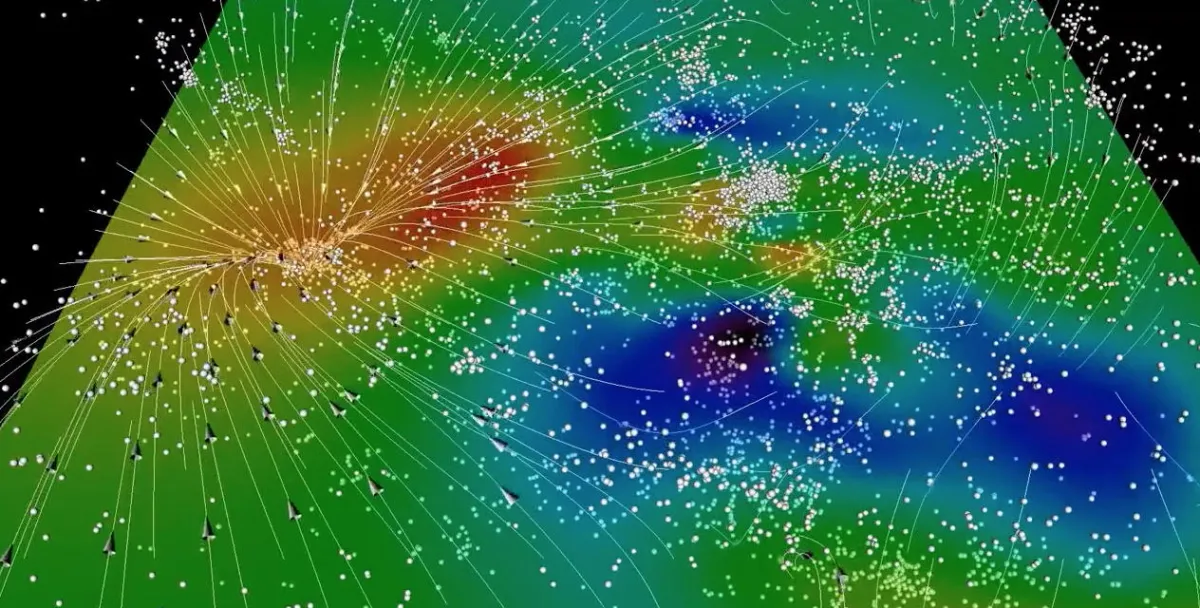Weighing gravity with galaxy motions
By mapping the motions of many galaxies, this project aims to precisely measure the amount and distribution of both visible and dark matter and test Einstein’s theory of gravity.
Research themes
Content navigation
About

By mapping the motions of many galaxies, this project aims to precisely measure the amount and distribution of both visible and dark matter and test Einstein’s theory of gravity. The project will apply sophisticated analysis to existing datasets and world-leading new surveys from the Australian Square Kilometre Array Pathfinder and the Anglo-Australian Telescope. It will yield by far the most extensive and accurate map of galaxies and their motions in the Universe to date. The rate of growth of structure in this map will reveal the total amount of matter and the nature of gravitational attraction on the largest scales.
As well as expanding with the Universe, galaxies fall into mass concentrations under gravity, forming large-scale flows. These ‘peculiar velocities’ (i.e. the velocities specific to individual galaxies) result from the effect of gravity on the mass distribution, revealing how matter (including the invisible ‘dark’ matter) is distributed throughout the Universe and the way that gravity acts on matter. Specifically, the complex pattern of these flows shows how dark matter is distributed, while the evolving rate at which flows create large-scale structures shows how gravity works on different scales.
This project combines world-leading expertise in studying large scale structures and motions and Australia’s major investment in the ASKAP radio array to exploit vast new surveys of galaxy peculiar velocities as powerful complements to redshift surveys. By measuring the peculiar velocities of greater numbers of galaxies than ever before and applying our innovative analytic methods, we will map their large-scale motions and the rate at which structure forms, and so precisely determine the amount and distribution of all the matter in the Universe (both luminous and dark) and test, on the largest scales, the nature of the gravitational force. The project is timely because of the vast amount of peculiar velocity data becoming available in the next few years. It will set a new benchmark for analysis of peculiar velocity surveys, fill a vital gap in current cosmological measurements, and make a key test of a fundamental physical theory.
The top-level science goals of this project are to exploit the best new surveys of galaxy peculiar velocities in order to test the standard cosmological model’s predictions for the amount and distribution of matter and to test the underlying theory of gravity to distinguish Einstein’s General Relativity from alternative models.
Specifically, the project will...
[1] Map the density and velocity field of the nearby Universe with greater precision than ever before. We will combine innovative analysis methods with the best existing peculiar velocity surveys and ongoing major surveys to derive maps of both the galaxy density and velocity fields. The new maps made by this project will be more extensive (~3x greater volume), detailed (~2x denser sampling), precise (~20% smaller errors) and accurate (better calibrated) than all earlier maps. The statistical properties of the density and velocity fields in these maps, and their joint consistency, provide fundamental tests of the cosmological model as well as independent measurements of key parameters that complement and improve on results from galaxy redshift surveys.
[2] Test Einstein’s theory of gravity on the largest scales using the growth rate of structure. This project will measure how fast large-scale structures are growing at recent times (the ‘growth rate’, f.sigma_8) with 3x the precision of the best current estimates. Combining measurements of the growth rate of structure in the Universe over a range of redshifts (cosmic epochs) is a powerful test of whether General Relativity (GR) is the true theory of gravity on scales up to a billion light-years. GR predicts the growth rate should vary with redshift as a specific power of the matter density. Any deviation from this prediction would provide a vital clue to modifying the theory and selecting alternatives. The measurements derived from the new surveys, covering most of the sky and using improved methods, will reduce the overall uncertainty in the growth rate on large scales from about 8% to less than 3%, tightening the constraints on the range of viable theories of gravity by about a factor of three.

